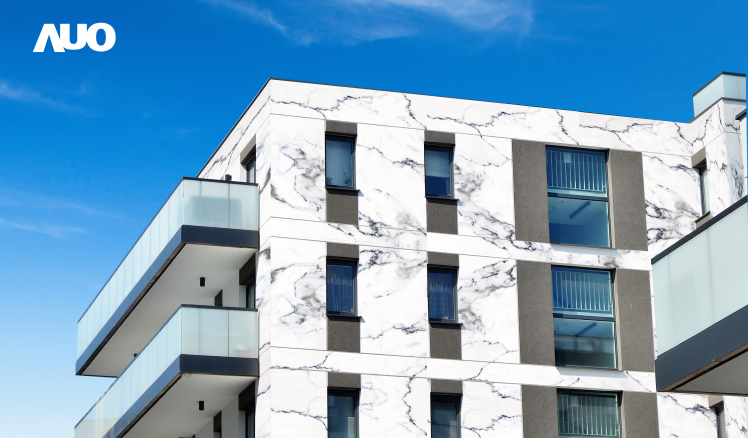According to International Energy Agency (IEA), more than one-third of the global energy consumption comes from the building industry, which also contributes 40% carbon emissions worldwide. In the pursuit of zero carbon emissions by 2050, the energy efficiency of buildings has become an important issue. Despite the increasingly sophisticated photovoltaics technology, the aesthetics dimensions are still lacking. In light of this, AUO has targeted the energy-saving and energy-generating potential of zero energy buildings to further tap into the possibilities of all-encompassing photovoltaics development. During the Taipei Building Show 2021 between December 9 and 12, AUO will debut its SunBello Aesthetic Building Integrated PV Solutions that combine energy-generating performance, esthetic design, smart microgrid, and energy storage management, culminating in aesthetic and sustainable buildings with zero energy consumption.
In recent years, the international society is actively promoting the zero energy building or nearly zero energy buildings, while the development of zero energy buildings in Taiwan has evolved as a popular trend. Unlike traditional green buildings that emphasize energy conservation, “zero energy buildings” feature green energy-generation, energy storage, energy-saving, and smart energy management technology, where 2 major systems, deep energy-saving and energy-generation, reduce energy consumption to zero or even become positive energy buildings. Starting from vertically integrated solutions for photovoltaic modules, AUO has developed complete solutions for the construction and maintenance of photovoltaic power stations, as well as BAPV/BIPV system solutions to achieve the seamless integration of photovoltaic application and architectural components, thereby providing buildings with uninterrupted green energy.
Integrated Design Achieves Benefits of Energy, Carbon reduction, Heat insulation, and Aesthetics
In the past, architectural aesthetics was lack due to the independent nature of the photovoltaic equipment and the buildings. AUO’s SunBello Aesthetic Building Integrated PV Solutions employs the Digital Ceramic Inks® patented technology to embed customized motifs into the photovoltaic construction materials to achieve the 4 major benefits of energy, carbon reduction, heat insulation, and aesthetics. In terms of energy and carbon reduction benefits, the energy-generating equipment supplies energy to the building’s interior and exterior, while carbon reduction is attained through renewable energy. In terms of heat insulation, the photovoltaic panels not only generate energy but also insulate heat, thereby significantly decreasing the interior air conditioning cost. To satisfy the esthetic needs of the buildings, general stone materials and world-renowned paintings are complemented by multi-busbar photovoltaic cell technology and narrow wire technology to minimize the frontal visibility of the metal wire grid, in turn endowing photovoltaic cells with artistic and high-tech qualities. As a result, the product not only shatters the stereotype of photovoltaic modules but also won the 2022 Taiwan Excellence Award.
|
In regards to rooftop space utilization, installing photovoltaic systems to conventional corrugated roofing usually involve complex secondary construction projects that are prone to water leaks. AUO also unveiled the SunSteel PV Metal Roofing System for the first time, allowing for the installation of the photovoltaic system while installing the corrugated roofing, thereby saving time and improving quality. Since there is no need for the traditional metal brackets, the overall weight of the photovoltaic system can be decreased, in turn minimizing the building’s structural loading weight and carbon footprints.
Residential Smart Microgrid Ensures Optimized Power Consumption Quality AUO’s SunBello Aesthetic Building Integrated PV Solutions also integrate the solar power, energy storage, and energy management system to provide a modular, quick to establish smart microgrid and energy storage integrated management platform, endowing the building’s energy system with energy-generating, energy-storage, and energy-saving benefits. This ensures the power quality of the renewable energy system and power grid, as well as a balanced power supply between peak and off-peak periods through the software/hardware integration of the energy storage system. As a result, energy applications can become more flexible, while the platform’s data visualization allows the formulation of the most efficient power consumption strategy to realize the concept of zero energy buildings.
Frameless Module Installation Realizes the BIPV Aesthetic Unlike the fixed mounts and exposed brackets of traditional construction methods, which are not only unaesthetic but also dangerous, AUO’s concealed wall photovoltaic modules can be preinstalled in system brackets, while the hidden mounts are located on the sides of the brackets to resolve the problem of exposed brackets. Such arrangement not only decreases the distance between adjacent modules but also retains the joining effect of the motifs as well as enhances convenience and safety. Furthermore, AUO has applied nano-coating technology to the photovoltaic panels, preserving the balance between the vibrantly colored exterior and glass transmittance, while the customized motifs endow the photovoltaic panels with artistic and high-tech qualities. AUO’s comprehensive team of highly technical specialists will provide our clients with complete products and services from site assessment, module installation, to the final system maintenance and operation. |

AUO SunBello Aesthetic Building Integrated PV solutions materialize benefits of energy, carbon reduction, heat insulation, and aesthetics.

To satisfy the esthetic needs of the buildings, AUO endows photovoltaic cells with artistic and high-tech qualities to shatter the stereotype of photovoltaic modules.

AUO debuts SunSteel PV Metal Roofing System, allowing for installation of the photovoltaic system while installing the corrugated roofing to save time, improve quality and reduce weight of the photovoltaic system. |